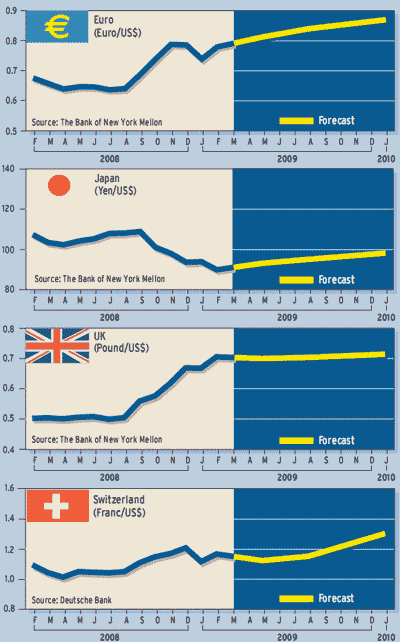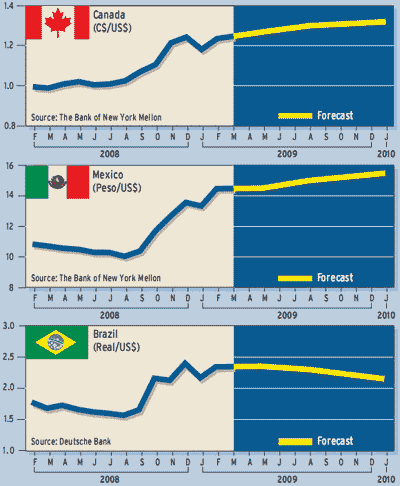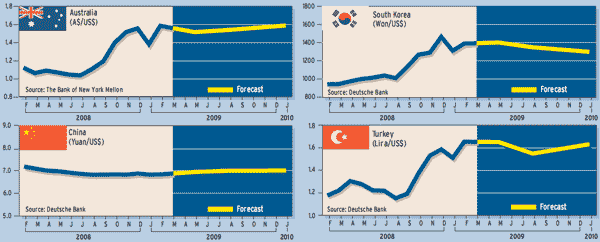Foreign Exchange
 Weak economic data from the eurozone, heralding further interest rate reductions in Europe, are helping to keep the dollar strong. Meanwhile, Japan’s worsening trade statistics are raising warning signals about the high-flying yen, analysts say.
Weak economic data from the eurozone, heralding further interest rate reductions in Europe, are helping to keep the dollar strong. Meanwhile, Japan’s worsening trade statistics are raising warning signals about the high-flying yen, analysts say.
The yen has been the best performing major currency since the global credit crisis began in the summer of 2007, says Binky Chadha, chief strategist at Deutsche Bank Securities, based in New York. From its lows in July 2007 through the end of January 2009, the yen rose by 43% in trade-weighted terms, 37% against the dollar and 40% against the euro. The Japanese currency doubled against the British pound and the New Zealand dollar in the same period.
This strong performance reflected the confluence of a set of supportive factors, including a cheap initial valuation, narrowing yield differentials and rising risk aversion, Chadha says. The initial phase of yen appreciation also reflected improvements in Japan’s basic balance, which is the sum of the country’s current-account balance and net foreign direct investment (FDI) flows, he says.
Just prior to the start of the credit crisis in July 2007, the yen had fallen to 20% below its fair value against the dollar, Chadha says. As the Federal Reserve cut interest rates and other countries followed, the yield disadvantage of the yen steadily narrowed. The Japanese currency has traditionally benefited from a flight to safety during periods of risk aversion marked by heightened volatility in financial markets, according to Chadha.
“The yen is no longer cheap against the dollar, but it is not unduly expensive either, while it is near fair value against the
 euro and approaching very expensive levels against sterling,” Chadha notes.
euro and approaching very expensive levels against sterling,” Chadha notes.
The Japanese basic balance has deteriorated dramatically, as the trade balance has shifted from surplus to deficit and FDI outflows have continued, Chadha says. “The basic balance should improve, as FDI outflows invariably slow in an environment of continued risk aversion,” he says. But a persistence of the trade deficit until a global recovery takes hold would argue for the basic balance remaining well below the last peak, he explains.
Cyclical and structural drivers of the yen are signaling a weaker Japanese currency, Chadha says. With the yield differential against the dollar having already fallen to close to zero, with volatility expected to decline to more normal levels and with the deterioration in Japan’s basic balance expected to persist, these factors are all arguing for a significantly weaker yen over the medium term, he says.
Meanwhile, prospects for the euro have deteriorated following the spread of economic and financial problems on the eurozone’s eastern front. The euro fell in early February on news that Fitch downgraded Russia’s debt rating to triple-B with a negative outlook and Kazakhstan’s central bank devalued the tenge by 25% against the dollar.
With the Russian and Kazakh currency pegs likely to remain under pressure, other regional pegs are going to come under pressure, too, says Win Thin, senior currency strategist at Brown Brothers Harriman, based in New York. The Baltic countries of Estonia, Latvia and Lithuania, as well as Bulgaria, all have currency pegs.
“We could see dominoes falling in Eastern Europe,” Thin says. “The longer this crisis drags on, the higher that probability becomes.”
Risk aversion will make it costly and difficult to roll over short-term external debt from emerging market borrowers, which could easily turn into a currency crisis in Eastern Europe, Win says. “Given Western banking exposure to Eastern Europe, this is very negative for the euro,” he points out.
The other option besides devaluation would be for these currencies to join the euro. However, there is a growing sense of enlargement fatigue in the core eurozone countries, Win says. “Germany and France are seeing the euro come under pressure, due in large part to the deteriorating fundamentals of weak links in Ireland, Greece and Spain,” he says. “Do they really want to add even weaker countries like the Baltics or Bulgaria?”
The European Central Bank held its benchmark rate at 2% in February, marking the first time since last October that it decided not to cut rates. ECB president Jean-Claude Trichet left the door open for further cuts as early as this month but said a zero interest rate policy did not seem to be appropriate at this stage.
“The ECB may not have the policy levers at its disposal to engage in quantitative easing,” says Marc Chandler, global head of currency strategy at Brown Brothers Harriman. “If it were to buy bonds with newly printed euros, whose bonds would it buy, and how is the decision to be made? There are no European assets, only national assets,” he says.
The ECB may simply not have the tools available to explore non-conventional policy prescriptions, according to Chandler. “This is one of the institutional consequences of having monetary union without political union,” he says.
Countries such as the United States, Britain and Japan have a distinct advantage over eurozone members in that the former are currency issuers in a way that Germany, France, Spain and the other countries that have adopted the euro are not, Chandler says. This is one of the reasons that talk of the euro replacing the dollar as the world’s chief reserve asset is grossly exaggerated, he says.
“We continue to believe that the multi-year bull market for the euro is over and the risk of the euro returning to its birth rate in the high teens is the most likely scenario,” Chandler says. The euro was introduced as an accounting currency on January 1, 1999, at a rate of $1.18.
Meanwhile, the Bank of England cut its policy rate by half a percentage point in February to a record low 1%. The bank’s Monetary Policy Committee (MPC) opted not to embark on a quantitative easing just yet, but it is only a question of time before this happens, Chandler says. The MPC is expected to begin buying corporate bonds, commercial paper and other assets. The pound rose following the rate cut and in reaction to news that the price of the average UK house rose 1.9% in January.
The Bank of England quarterly inflation report, released February 11, showed inflation tracking well below target and forecast it could reach 0.5% in two years. The bearish report said all the risks are on the downside for growth and inflation.

Gordon Platt



